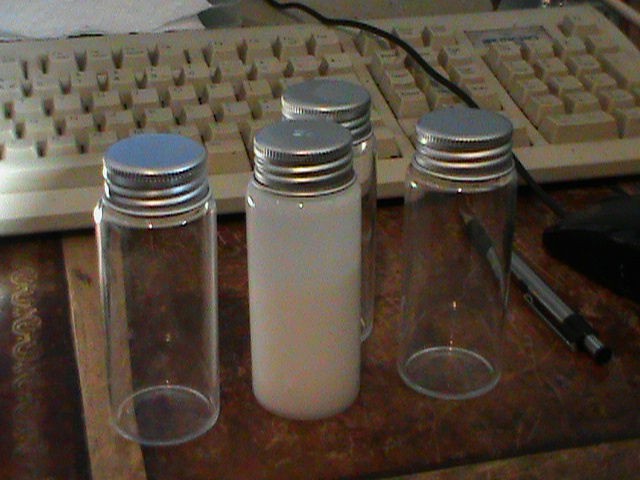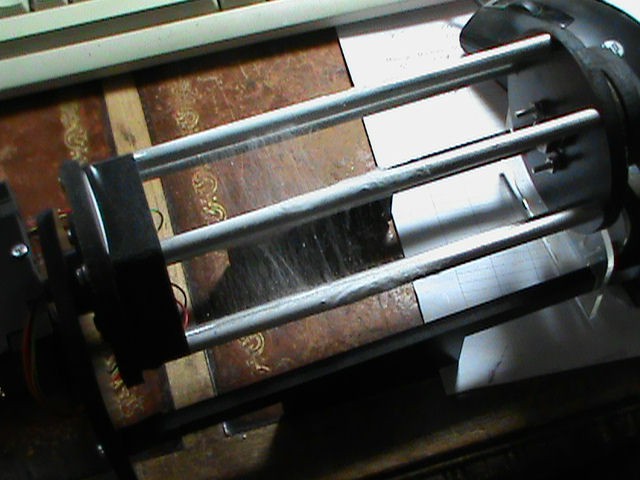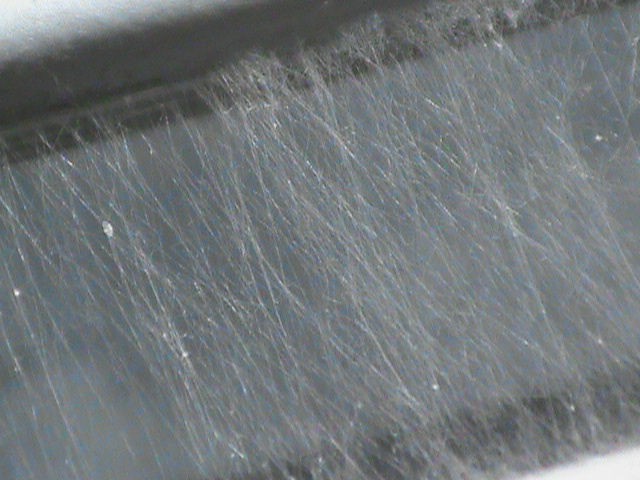A lot going on the past few days.
First off, I've pretty much nailed down
the settings needed to reliably pull ABS. I don't worry about pulling
>200mm long fibers anymore, thin as spider silk. Piece of cake.
The secret was in the solvent/ABS ratio, specifically I had it too
low. I'm having a lot better luck with it almost being to the point
that the solvent is saturated with ABS and can't hold any more.
I was also running into areas where the
material was thinned out too much, giving me much shorter fibers. I
took care of that by sticking the bottle of the mix into a ultrasonic
eyeglass cleaner for a bit to mix it up thoroughly. That made a big
difference. I won't start a run with doing that from now on, even
with a freshly mixed batch.
I picked up these small glass bottles
at Hobby Lobby cheap, and they work great for preparing a batch and
doing the ultrasonic mixing.

Producing mats is easy. After figuring out that ABS likes to be pulled with the positive lead on the plate and the negative on the emitter I can get the landing area much smaller and under control. No more stuff flying all over the place. The mats are easy to pull apart when they're done, so I'm doing a bit of post-processing on them. That consists of the highly technical feat of pointing a hot air gun at them to get the fibers to better fuse to each other. When that's done the mats hold together real well but are still flexible. You can ball them up in your hand without damaging them in the least. That'll be the form I want to form electrical circuits on.
So with all that worked out, it's time
to do some real work, right? Well, this is where the 'own worst
enemy' thing comes into it.
My next thing is to make conductive
fibers, which I've already done to a degree. What I want now is to
make the fibers in the mat line up side by side. To do that is what
the rotary drum is for. As the fibers touch the drum the fibers are
pulled down in the direction of the spinning drum. Cool, just what I
need. For some reason when I put the drum in the machine I didn't
think about the effects the reversed polarity would have. Well, it
turns out when a drum charged to 20 kV gets within a couple of inches
of a stepper motor, it'll find a way around the guards.
Yeah, I know, not too smart, right?
End result is the stepper driver board
now has one dead output on it, so running a stepper is out on that
channel. So I'm back to the DC motor I didn't really like before. I
took a day and made another rotary, this one with six rods instead of
a solid drum. The idea is the fibers will bridge the gap between the
rods and be easy to collect. Turns out that idea works just find.
It's fed by a separate power supply for now.
Here's what the new rotary looks like.

I did a quick five minute run with it
and as you can see the fibers lined up nicely. Still can't go too
high on the voltage, though. But it'll take up to about 20kV before
giving me problems, and ABS pulls nicely at between 16 kV and 18 kV.
So we're good there for now.

The theory is that when the mix is spiked to produce conductive fibers that the resistance will be less along the long axis than it will be side to side. That's because the conductive material will be aligned inside the fibers along it's long axis. That's the whole reason to use electrospinning to produce them.
I 'think' (believe it or not) that I'm
about ready to put all this preliminary stuff behind me and make the
good stuff. I know I've thought that before but this time I mean it.
Lol. But things happen, and building, blowing circuits and rebuilding
the rotary yet again is just part of the process. Or, at least, is it around here right now.
I'll have more for you soon.
 Douglas Miller
Douglas Miller
Discussions
Become a Hackaday.io Member
Create an account to leave a comment. Already have an account? Log In.